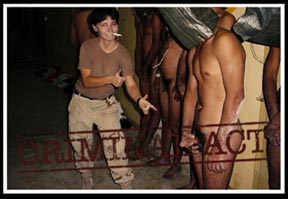Director: Errol Morris,
Watched in: Theater
Rating: 2/5.
With Standard Operating Procedure, investigative stylist Errol Morris dissects the Abu Ghraib prison scandal by forcing us to look, over and over and over again, at the photographs that brought the scandal to the world’s attention. He also digs out several other snapshots, much more graphic, revealing, and repellent than the ones we saw in the mainstream press. He intersperses these photos with several talking head interviews of soldiers and investigators involved in the mess and with highly cinematic recreations or imaginings of the events. These exotically lit and elaborately art directed sequences are standard operating procedure for Morris as a filmmaker but, like the guards at Abu Ghraib, he has gone too far.
Morris seems to be relishing too much the opportunity to visualize the sordid events that occurred at Abu Ghraib. He fetishizes the extreme close-ups of blood, bits of hair, and steel bars. Some scenes are lit with an eye for erotic sleaze, as if they were excerpts from a Nazi stag film. Other moments are rendered in shadows and silhouette, with pools of–one assumes–urine or blood shimmering in the foreground. The onslaught of these scenes, cut together with photographs showing Iraqi men stripped naked and forced into humiliating positions, and other photographs of the guards laughing or taking crude pictures of each other, combined with the endless interviews of soldiers (some of whom seem, I hate to say it, not very bright), adds up to an excruciating and often repulsive 2 hours of movie watching.
I have always been a fierce admirer and defender of Errol Morris. He awakened the movie world to a new way of making documentaries in 1988 with The Thin Blue Line, a picture that was bold both in aesthetics and intent. It changed what was possible in the making of documentaries and it also helped free an innocent man from prison. Morris’ technique, a combination of metaphor, reenactment, and straight-to-the-camera interviews, was seductive and mesmerizing. Since then, his films have been more interesting for their visual rather than their journalistic content, which is really just fine with me. I’ll take a doc made with cinematic flair over the routine issue-heavy activist video any day. But with Standard Operating Procedure it appears Morris has lost his bearings.
His overall point here, I think, is for us to understand two things about Abu Ghraib. Point one, which he makes in the first 10 minutes, is that the humiliation and torture of prisoners was a top down decision. The guards weren’t acting without the complicity of their commanders. Still though, one gets the feeling that if the soldiers involved had blown the whistle early on, the abuse would have ended and the people in charge, rather than the soldiers, would have taken the fall. The second point Morris attempts to make is that the photos themselves were misleading. Some of the abuse pictured was staged and simulated simply to get a picture, after which the prisoners were allowed to go back to their cells. He wants to say something about perception, which is a consistent theme for the director, but the redundant imagery, the tiresome interviews, and a reluctance to dig deeper or venture beyond the walls of the prison, results in a fatally one-dimensional film.
The best interview here is with the former commander in charge of Abu Ghraib, Colonel Janice Karpinski, who was demoted from the rank of general and scapegoated for the scandal. Karpinski is an angry, strong-willed character, and every time she comes on screen the movie lit up with the promise of a meatier, more incisive investigation up the chain of command. She contends the Abu Ghraib orders came from Donald Rumsfield. Maybe, just maybe, Morris will come back to her story and give the colonel her own film.

